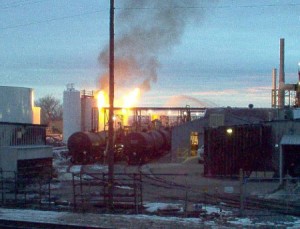![]() Tweet Via NPR‘s All Things Considered, from correspondent Richard Harris, Feds Delay Decision On Pipeline Project
Tweet Via NPR‘s All Things Considered, from correspondent Richard Harris, Feds Delay Decision On Pipeline Project
The State Department is delaying a decision for at least a year on whether to approve the Keystone pipeline. The $7 billion pipeline would carry oil from the tar sands of Alberta, Canada, through the U.S. to Gulf of Mexico refineries. Nebraska’s state government and environmental groups have put intense pressure on the State Department and White House to reject the pipeline’s proposed route. NPR’s Richard Harris talks with Robert Siegel about the project.
Audio here (available after 1900 hours Eastern time, 10 November 2011).
Wikipedia’s entry Keystone XL Pipeline has a detailed – and, in our view, fair – account of the controversy. While on balance we do not support the Keystone pipeline, a very well-reasoned argument in favor of the pipeline can be foundon the blog of JEH Land Clearing, from which we’ve taken the following map of the proposed pipeline (route in red; other pipelines indicated are already in existence/operation). 
The Texas economy will benefit from the increase in production. The area east of I-35 is consistently in economic hardship (Port Arthur’s unemployment rate is hovering around 15%), and the construction, land clearing, surveying and refinery jobs will help lower the staggering unemployment rate. It is estimated that the Keystone Pipeline will help create over 20,000 jobs. Texas alone will see over $2.3B in new spending and the US will see about $20B in new spending. The increase of personal income in the state will be about $1.6B and the US will see an increase of $6.5BB. Profits will be re-invested in the local economy improving the quality of life and increasing the number of business in the area. Regardless of where you stand on this issue, one fact remains; the only one way to get heavy crude from Canada to the Texas gulf coast is a pipeline.
Excerpted from Oil Pipeline Invigorates Texas Economy
We support public works projects as economic stimulus, particularly those which come with improvements to energy and other infrastructure; in our view a massive wind/solar public works project in Texas might have the same effective economic stimulus with a better energy outcome, with a significantly lower environmental impact
What JEH doesn’t mention are the costs in terms of environmental damage, water, and health effects. These are long term costs, which are, in the parlance of neoclassical economics, “externalized,”or pushed into the future, and pushed off the balance sheets, kind of like CDO’s, or Collatoralized Debt Obligations, made famous by the financial crisis. Ecological economics recognizes that these costs must be considered, just as recent economic history forces us to recognize the real value of mortgages and mortgage backed securities. As we are learning, ignoring risk is unwise. Put bluntly, the Keystone XL pipeline is kind of like a $1.0 Million “McMansion” sold for $25,000 down, with a $1.0 Million mortgage which is, of course, a negatively amortized interest-only note for the first 5 years – at which time the borrowers will have to pay $1.1 Million, plus interest. But in reality, the $5 billion pipeline is like an aggregated set of five thousand negatively amortizing $1.0 Million toxic McMortgages on McMansions built of radioactive materials on toxic waste sites below sea level.
We intend to elaborate on the costs, risks, and benefits of pipelines in future posts; as well as a series on the Bonneville Power Administration, which has been supplying electricity in the Northwest for almost 75 years, and which we think is a model for energy-related public works projects.

